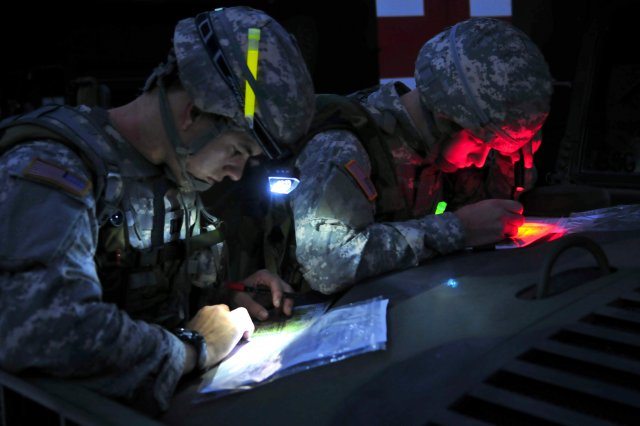New rating forms will be adopted next year as the Army implements significant changes to its Officer Evaluation System.
The new officer evaluation forms will come in three different versions or “grade plates” as they’re termed, based on the rank of rated officers. The new system will include profiles for raters (not just senior raters), and enable senior raters to better identify the very best officers in a competitive environment.
It’s the first time in history that “inflated” ratings are not the reason for changing the Officer Evaluation Report, said George Piccirilli, chief of the Evaluations, Selections and Promotions Division at Human Resources Command, or HRC, Fort Knox, Ky.
Piccirilli said the changes are instead aimed at instilling rater accountability, more accurately identifying elite performers and synching the report with current leadership doctrine.
Leadership doctrine has changed since 1997, Piccirilli said, when DA Form 67-9 was first adopted.
The new DA 67-10 will eliminate the 16 boxes for “attributes, skills and actions.” Instead raters will be required to write statements about an officer’s attributes, specifically “character, presence and intellect,” along with how the officer “leads, develops and achieves.”
The new form requires raters to be “more descriptive” and not just check blocks, Piccirilli said.
The new form is scheduled to be adopted in December 2013 by all components, including the National Guard and Army Reserve. Until then, training will be offered. Beginning in June, HRC will offer “train-the-trainer” courses at Fort Knox, Ky. Mobile training teams will visit commands and online training will be available.
“We’re trying to reduce anxiety,” Piccirilli said. “When we change something, we always have that anxiety.”
He said lieutenant colonels and above may especially feel anxiety at first about the senior-rater block on their OER that’s designed to identify the top 10 percent of talent.
The “top 10 percent block” will identify the “truly gifted and exclusive officers,” Piccirilli said, on OERs for lieutenant colonels and senior officers.
There will be three versions of the new OER: one for captains and below, another for field grade officers and chief warrant officers in the three highest grades and a third for colonels and brigadier generals, dubbed “strategic leaders.”
In addition, the field-grade OER will have a slightly different version for lieutenant colonels and chief warrant officers 5. For them, senior raters will have five blocks instead of four to evaluate potential. This includes the “top 10 percent” box and the “most qualified” box. The cumulative percentage of both boxes cannot exceed 49 percent.
The forms will be web-based and choosing the different versions will be “seamless” or transparent, according to Piccirilli. He said raters who access the Army Publishing Directorate website will click the rank of the officer they are rating and the proper form will automatically pop up.
“The form itself is not just a piece of paper,” Piccirilli said.” It’s the behavior that we drive to make sure we identify those right officers and that the raters are accountable for their assessments.”
HRC is developing the online application now, Piccirilli said, and working with the Army Publishing Directorate to perfect the different grade plates.
“We want to vary how we look at different grades,” Piccirilli said, “We want to engender rater accountability.”
Accountability will be developed because raters will only be able to check the top block on less than 50 percent of the officers they rate. Since the forms are filled out online, a “misfire” will occur if raters exceed that percentage.
Developing a profile for raters will force them to “make a call” about identifying top performers, Piccirilli said. It should also “reinvigorate” the importance of raters, according to HRC. Under the current system, raters can give all of their subordinates top blocks if they choose. Only senior raters have a profile and are limited to a percentage of top blocks.
The profile for senior raters on the current OER system has sometimes led to a practice called “pooling,” Piccirilli said. Pooling is when a large number of officers are senior-rated by a single individual who couldn’t possibly know the accomplishments of all subordinates.
For instance, pooling typically occurred when a brigade commander decided to senior rate all captains in his command, Piccirilli said, in order to enable all company commanders to receive top blocks. This however, limited what staff officers could expect on their evaluations.
Pooling is a practice the chief of staff of the Army specifically wants to eliminate with the new OER, Piccirilli said. He wants the new system to more fairly and accurately assess the performance and potential of all officers, Piccirilli emphasized.
Army Chief of Staff Gen. Ray Odierno and Secretary of the Army John McHugh have approved the new Officer Evaluation System. Notifications went out this week to all general officers, Piccirilli said.
Under the new system, OER support forms will still be mandatory for captains and below, but will be optional for field-grade officers and above. OER counseling will still be required for all officers, Piccirilli said, but he added the support form will be optional depending on the rater.
The new OERs will also help identify “broadening assignments” for field-grade officers, he said. Raters will be asked to recommend not only specific operational assignments for officers, but also must list appropriate broadening assignments such as fellowships, interagency and intergovernmental positions.
The OERs will be used by assignment officers, as well as promotion boards and command selection boards, Piccirilli said.
“This is the tool that we use to select our future leaders and the tool the assignment officers use to make sure we put the right quality into the right job,” he said.
Changes are also being looked at for the Noncommissioned Officer Evaluation Report, HRC officials said, but added that specifics have not been decided upon yet.











